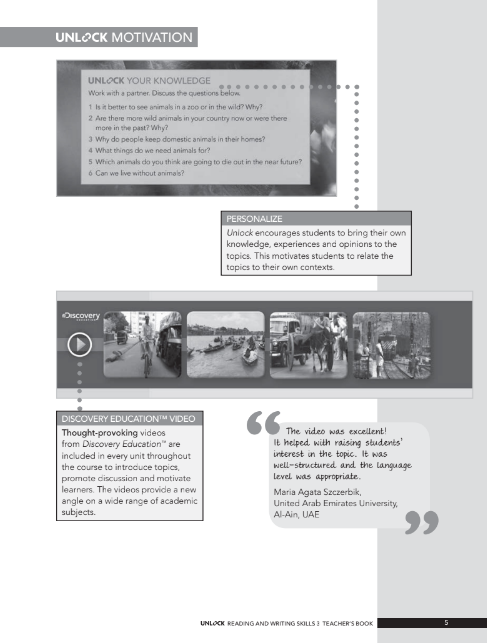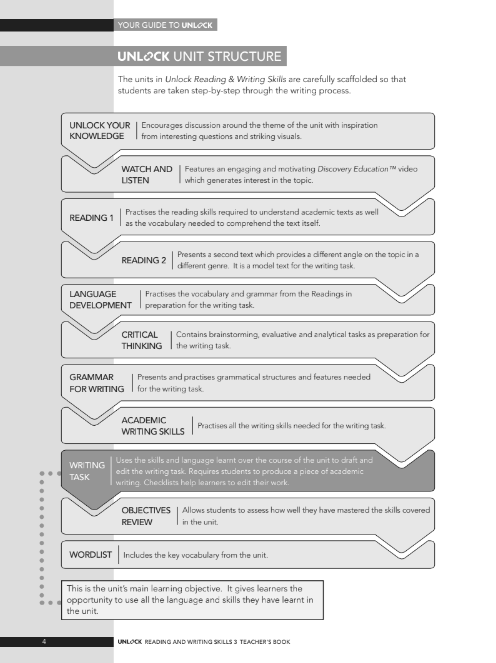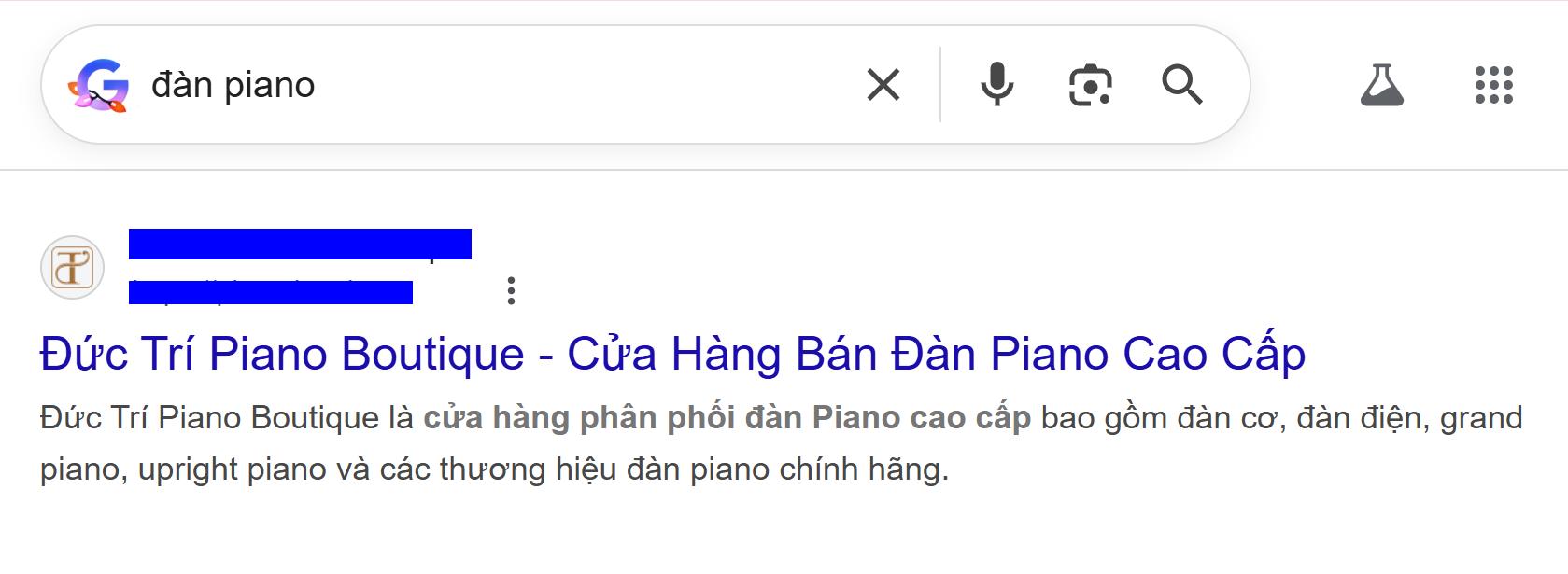


Mục lục
ToggleUNLOCK YOUR KNOWLEDGE
Encourages discussion around the theme of the unit with inspiration from interesting questions and striking visuals.
READING 1
Practises the reading skills required to understand academic texts as well as the vocabulary needed to comprehend the text itself.
GRAMMAR FOR WRITING
Presents and practises grammatical structures and features needed for the writing task.
LANGUAGE DEVELOPMENT
Practises the vocabulary and grammar from the Readings in preparation for the writing task.
WRITING TASK
Uses the skills and language learnt over the course of the unit to draft and edit the writing task. Requires students to produce a piece of academic writing. Checklists help learners to edit their work.
WORDLIST
Includes the key vocabulary from the unit.
WATCH AND LISTEN
Features an engaging and motivating Discovery Education™ video which generates interest in the topic.
READING 2
Presents a second text which provides a different angle on the topic in a different genre. It is a model text for the writing task.
ACADEMIC WRITING SKILLS
Practises all the writing skills needed for the writing task.
CRITICAL THINKING
Contains brainstorming, evaluative and analytical tasks as preparation for the writing task.
OBJECTIVES REVIEW
Allows students to assess how well they have mastered the skills covered in the unit.
The units in Unlock Reading & Writing Skills are carefully scaffolded so that students are taken step-by-step through the writing process.
MOTIVATION
PERSONALIZE
Unlock encourages students to bring their own knowledge, experiences and opinions to the topics. This motivates students to relate the topics to their own contexts.
“The video was excellent!
It helped with raising students’ interest in the topic. It was well-structured and the language level was appropriate.”
— Maria Agata Szczerbik, United Arab Emirates University, Al-Ain, UAE
DISCOVERY EDUCATION™ VIDEO
Thought-provoking videos from Discovery Education™ are included in every unit throughout the course to introduce topics, promote discussion and motivate learners. The videos provide a new angle on a wide range of academic subjects.
YOUR GUIDE TO CRITICAL THINKING
“The Critical thinking sections present a difficult area in an engaging and accessible way.”
— Shirley Norton, London School of English, UK
Learners engage in evaluative and analytical tasks that are designed to ensure they do all of the thinking and information-gathering required for the end-of-unit writing task.
BLOOM’S TAXONOMY (clean formatted list)
| Level | Skills |
|---|---|
| Create | create, invent, plan, compose, construct, design, imagine |
| Evaluate | decide, rate, choose, recommend, justify, assess, prioritize |
| Analyze | explain, contrast, examine, identify, investigate, categorize |
| Apply | show, complete, use, classify, examine, illustrate, solve |
| Understand | compare, discuss, restate, predict, translate, outline |
| Remember | name, describe, relate, find, list, write, tell |
The Critical Thinking sections in Unlock are based on Benjamin Bloom’s classification of learning objectives. This ensures learners develop both lower- and higher-order thinking skills, ranging from demonstrating knowledge and understanding to in-depth evaluation.
RESEARCH
ACADEMIC LANGUAGE
Unique research using the Cambridge English Corpus has been carried out into academic language, in order to provide learners with relevant academic vocabulary from the start (CEFR A1 and above). This ensures learners are presented with carefully selected essential words.
GRAMMAR FOR WRITING
The grammar syllabus focuses on sentence structure, word agreement and referencing, which are essential for coherent and organized academic writing.
THE CAMBRIDGE LEARNER CORPUS
This bank of official Cambridge English exam papers allows the identification of the most common learner errors, ensuring the syllabus teaches the most relevant language.
THE WORDS YOU NEED
Language Development sections provide vocabulary and grammar building tasks that are further practised in the online Workbook.
The glossary and wordlists provide definitions, pronunciation and summaries of key vocabulary.
“The language development is clear and the strong lexical focus is positive as learners feel they make more progress when they learn more vocabulary.”
— Colleen Wackrow, Princess Nourah Bint Abdulrahman University, Al-Riyadh, Kingdom of Saudi Arabia
YOUR GUIDE TO SOLUTIONS
ONLINE WORKBOOKS
Interactive exercises, games and further practice of language and skills.
CAMBRIDGE LEARNING MANAGEMENT SYSTEM
Allows teachers to track learner progress, automate marking, and support communication with blogs, forums and other tools.
FLEXIBLE
Unlock is available in various print and digital components for different teaching needs.
EBOOKS
Interactive eBooks include embedded answers and videos.
UNIT 2: CUSTOMS AND TRADITIONS
EXERCISE 1: PREVIEWING
Look at the photographs and complete the sentences.
- In an Indian wedding the bride has her (hands) painted with henna.
TEACHING TIPS
1. Using video in the classroom
The Watch and listen sections in Unlock are based on documentary-style videos from Discovery Education™. Each one provides a fresh angle on the unit topic and a stimulating lead-in to the unit.
There are many different ways of using the video in class. For example, you could use the video for free note-taking practice and ask learners to compare their notes to the video script; or you could ask learners to reconstruct the voiceover or record their own commentary to the video.
Try not to interrupt the first viewing of a new video; you can go back and watch sections again or explain things for struggling learners. You can also watch with the subtitles turned on when the learners have done all the listening comprehension work required of them.
See also: Goldstein, B. and Driver, P. (2014) Language Learning with Digital Video Cambridge University Press and the Unlock website for more ideas on using video in the classroom.
2. Teaching reading skills
Learners who aim to study at university will need to be comfortable dealing with long, complex texts. The reading texts in Unlock Reading & Writing Skills provide learners with practice obtaining meaning quickly from extensive texts.
Discourage your learners from reading every word of a text line-by-line and instead focus on skimming and scanning:
- Skimming – help promote quick and efficient reading. Ask learners to pass quickly over the text to get the basic gist, an awareness of the organization of the text, and the tone and intention of the writer.
- Scanning – help learners locate key data and reject irrelevant information in a text. Ask learners to run their eyes up, down and diagonally across the text looking for clusters of important words. Search for names, places, people, dates, quantities, lists of nouns and compound adjectives.
The reading texts demonstrate different genres such as academic text, magazine article or learner essay.
The Reading between the lines sections make learners aware of the different conventions of each genre. Understanding text genre should help prepare learners for the kind of content to expect in the text they are going to read.
Ask learners to use Reading 2 as a writing frame to plan their sentences, paragraphs and essays for the Writing task.
3. Managing discussions in the classroom
There are opportunities for discussion throughout Unlock Reading & Writing Skills. The photographs and the Unlock your knowledge boxes on the first page of each unit provide the first discussion opportunity. Learners could be asked to guess what is happening in the photographs or predict what is going to happen, for example. Learners could investigate the Unlock your knowledge questions for homework in preparation for the lesson.
Throughout the rest of the unit, the heading Discussion indicates a set of questions which can be an opportunity for free speaking practice. Learners can use these questions to develop their ideas about the topic and gain confidence in the arguments they will put forward in the Writing task.
To maximise speaking practice, learners could complete the discussion sections in pairs. Monitor each pair to check they can find enough to say and help where necessary. Encourage learners to minimise their use of their own language and make notes of any error correction and feedback after the learners have finished speaking.
An alternative approach might be to ask learners to role-play discussions in the character of one of the people in the unit. This may free the learners from the responsibility to provide the correct answer and allow them to see an argument from another perspective.
4. Teaching writing skills
Learners work towards the Writing task throughout the unit by learning vocabulary and grammar relevant for the Writing task, and then by reading about the key issues involved in the topic. Learners gather, organise and evaluate this information in the Critical thinking section and use it to prepare the Writing task. By the time learners come to attempt the Writing task, they have done all the thinking required to write.
They can do the Writing task during class time or for homework. If your learners require exam practice, set the writing task as a timed test with a minimum word count similar to the exam the learners are training for and do the writing task in exam conditions. Alternatively, allow learners to work together in class to do the Writing task and then set the Additional writing task in the Teacher’s Book as homework.
Task and Language Checklists
Encourage your learners to edit their written work by referring to the Task checklist and Language checklist at the end of the unit.
Model answers
The model answers in the Teacher’s Book can be used in a number of ways:
- Photocopy the Writing task model answer and hand this to your learners when you give feedback. You can highlight useful areas of language and discourse structure to help the learners compose a second draft or write a response to the additional writing tasks.
- Use the model answer as a teaching aid. Photocopy the answer and cut it up into paragraphs, sentences or lines then ask learners to order it correctly.
- Use a marker pen to delete academic vocabulary, key words or functional grammar. Ask learners to replace the missing words or phrases. Learners can test each other by gapping their own model answers which they swap with their partner.
Additional writing tasks
There are ten Additional writing tasks in the Teacher’s Book, one for each unit. These provide another opportunity to practise the skills and language learnt in the unit. They can be handed out or carried out on the Online Workbook.
5. Teaching vocabulary
The Wordlist at the end of each unit includes topic vocabulary and academic vocabulary. There are many ways that you can work with the vocabulary. During the early units, encourage learners to learn new words by setting regular review tests. You could ask learners to choose for example five words from the unit vocabulary to learn. You could later test your learners’ use of the words by asking them to write a short paragraph incorporating the words.
Use the end-of-unit Wordlists and the Glossary at the back of the book to give extra spelling practice. Set spelling tests at the end of every unit or dictate sets of words from the glossary which follow spelling patterns or contain common digraphs (th, ch, sh, ph, wh) or prefixes and suffixes (al-, in-, -tion, -ful). You could also dictate a definition from the Glossary in English or provide the words in your learner’s own language to make spelling tests more challenging.
6. Using the Research projects with your class
There is an opportunity for students to investigate and explore the unit topic further in the Research projects which feature at the end of each unit in the Teacher’s Books. These are optional activities which allow learners to work in groups (or individually) to discover more about an aspect of the topic, carry out a problem-solving activity or engage in a task outside the classroom.
Learners can use the Cambridge LMS tools to share their work with the teacher or the whole class.
7. Using digital components: Online workbook and the Cambridge Learning Management System (LMS)
The Online Workbook provides:
- Additional practice of the key skills and language covered in the Student’s Book.
- End-of-unit Writing tasks and Additional writing tasks.
- A gradebook to track learner progress.
- Games for vocabulary and language practice.
The Cambridge LMS provides tools such as:
- Blogs – for free writing practice
- Forums – for discussions
- Wikis – ideal for whole-class project work
The LMS also allows teachers to track progress, manage assignments and communicate efficiently.
8. Using Unlock interactive eBooks
Unlock Reading & Writing Skills Student’s Books are available as fully interactive eBooks. The content is the same as the printed book but with embedded audio and video.
Using eBooks in class may change the class structure, since learners can:
- Access video and audio independently
- Check answers with the built-in key
- Use class time for discussions and productive work
9. Using mobile technology in the language learning classroom
By Michael Pazinas, Curriculum and Assessment Coordinator, UAE University.
The guiding principle for mobile technology in the language classroom should be to create as many meaningful learning opportunities as possible. While mobile technology can be a powerful tool, it should support a larger learning strategy.
The research projects in the Teacher’s Book aim to add elements of hands-on inquiry, collaboration, critical thinking and analysis. They present real challenges which learners must research and solve. They can be used for groups or individuals.
Learner devices can become:
- Research libraries
- Film, art and music studios
- Podcast stations
- Marketing offices
- Blog-creation tools
Michael has first-hand experience developing materials for the paperless classroom and is the author of the Research projects featured in the Teacher’s Books.



